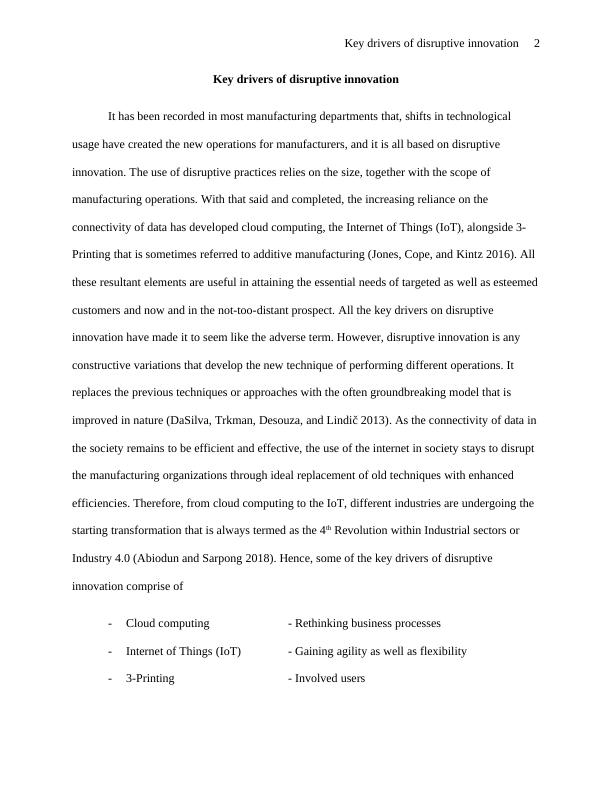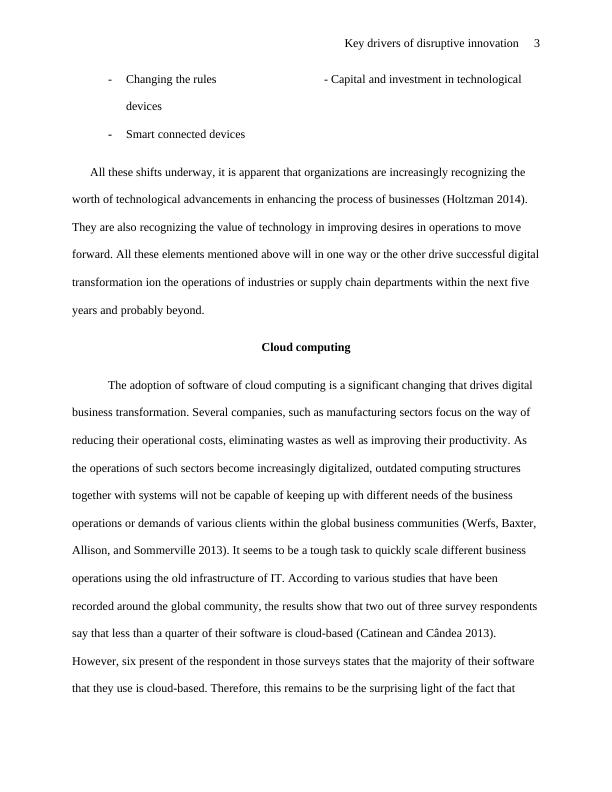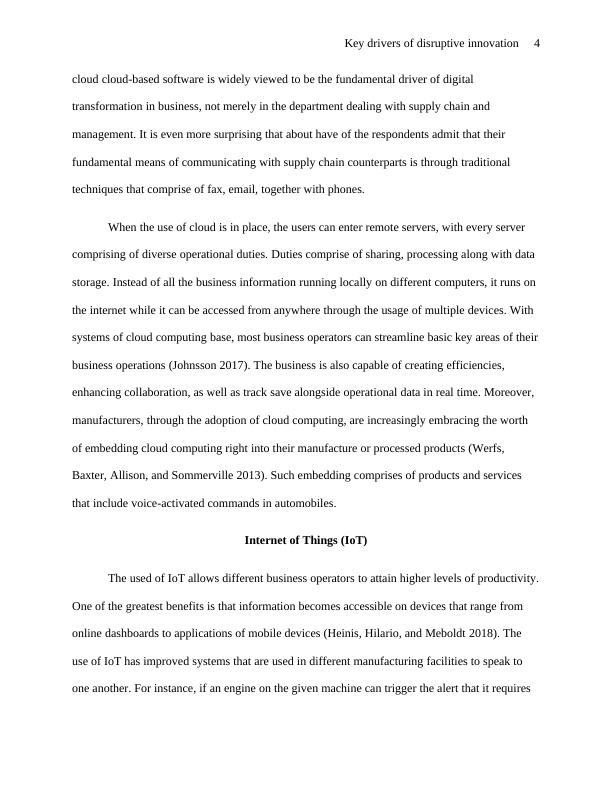Key drivers of disruptive innovation
Added on 2022-11-28
12 Pages3117 Words491 Views
Key drivers of disruptive innovation 1
WHAT ARE THE KEY DRIVERS OF DISRUPTIVE INNOVATION?
Name:
Institution:
Course:
Tutor:
Date:
WHAT ARE THE KEY DRIVERS OF DISRUPTIVE INNOVATION?
Name:
Institution:
Course:
Tutor:
Date:

Key drivers of disruptive innovation 2
Key drivers of disruptive innovation
It has been recorded in most manufacturing departments that, shifts in technological
usage have created the new operations for manufacturers, and it is all based on disruptive
innovation. The use of disruptive practices relies on the size, together with the scope of
manufacturing operations. With that said and completed, the increasing reliance on the
connectivity of data has developed cloud computing, the Internet of Things (IoT), alongside 3-
Printing that is sometimes referred to additive manufacturing (Jones, Cope, and Kintz 2016). All
these resultant elements are useful in attaining the essential needs of targeted as well as esteemed
customers and now and in the not-too-distant prospect. All the key drivers on disruptive
innovation have made it to seem like the adverse term. However, disruptive innovation is any
constructive variations that develop the new technique of performing different operations. It
replaces the previous techniques or approaches with the often groundbreaking model that is
improved in nature (DaSilva, Trkman, Desouza, and Lindič 2013). As the connectivity of data in
the society remains to be efficient and effective, the use of the internet in society stays to disrupt
the manufacturing organizations through ideal replacement of old techniques with enhanced
efficiencies. Therefore, from cloud computing to the IoT, different industries are undergoing the
starting transformation that is always termed as the 4th Revolution within Industrial sectors or
Industry 4.0 (Abiodun and Sarpong 2018). Hence, some of the key drivers of disruptive
innovation comprise of
- Cloud computing - Rethinking business processes
- Internet of Things (IoT) - Gaining agility as well as flexibility
- 3-Printing - Involved users
Key drivers of disruptive innovation
It has been recorded in most manufacturing departments that, shifts in technological
usage have created the new operations for manufacturers, and it is all based on disruptive
innovation. The use of disruptive practices relies on the size, together with the scope of
manufacturing operations. With that said and completed, the increasing reliance on the
connectivity of data has developed cloud computing, the Internet of Things (IoT), alongside 3-
Printing that is sometimes referred to additive manufacturing (Jones, Cope, and Kintz 2016). All
these resultant elements are useful in attaining the essential needs of targeted as well as esteemed
customers and now and in the not-too-distant prospect. All the key drivers on disruptive
innovation have made it to seem like the adverse term. However, disruptive innovation is any
constructive variations that develop the new technique of performing different operations. It
replaces the previous techniques or approaches with the often groundbreaking model that is
improved in nature (DaSilva, Trkman, Desouza, and Lindič 2013). As the connectivity of data in
the society remains to be efficient and effective, the use of the internet in society stays to disrupt
the manufacturing organizations through ideal replacement of old techniques with enhanced
efficiencies. Therefore, from cloud computing to the IoT, different industries are undergoing the
starting transformation that is always termed as the 4th Revolution within Industrial sectors or
Industry 4.0 (Abiodun and Sarpong 2018). Hence, some of the key drivers of disruptive
innovation comprise of
- Cloud computing - Rethinking business processes
- Internet of Things (IoT) - Gaining agility as well as flexibility
- 3-Printing - Involved users

Key drivers of disruptive innovation 3
- Changing the rules - Capital and investment in technological
devices
- Smart connected devices
All these shifts underway, it is apparent that organizations are increasingly recognizing the
worth of technological advancements in enhancing the process of businesses (Holtzman 2014).
They are also recognizing the value of technology in improving desires in operations to move
forward. All these elements mentioned above will in one way or the other drive successful digital
transformation ion the operations of industries or supply chain departments within the next five
years and probably beyond.
Cloud computing
The adoption of software of cloud computing is a significant changing that drives digital
business transformation. Several companies, such as manufacturing sectors focus on the way of
reducing their operational costs, eliminating wastes as well as improving their productivity. As
the operations of such sectors become increasingly digitalized, outdated computing structures
together with systems will not be capable of keeping up with different needs of the business
operations or demands of various clients within the global business communities (Werfs, Baxter,
Allison, and Sommerville 2013). It seems to be a tough task to quickly scale different business
operations using the old infrastructure of IT. According to various studies that have been
recorded around the global community, the results show that two out of three survey respondents
say that less than a quarter of their software is cloud-based (Catinean and Cândea 2013).
However, six present of the respondent in those surveys states that the majority of their software
that they use is cloud-based. Therefore, this remains to be the surprising light of the fact that
- Changing the rules - Capital and investment in technological
devices
- Smart connected devices
All these shifts underway, it is apparent that organizations are increasingly recognizing the
worth of technological advancements in enhancing the process of businesses (Holtzman 2014).
They are also recognizing the value of technology in improving desires in operations to move
forward. All these elements mentioned above will in one way or the other drive successful digital
transformation ion the operations of industries or supply chain departments within the next five
years and probably beyond.
Cloud computing
The adoption of software of cloud computing is a significant changing that drives digital
business transformation. Several companies, such as manufacturing sectors focus on the way of
reducing their operational costs, eliminating wastes as well as improving their productivity. As
the operations of such sectors become increasingly digitalized, outdated computing structures
together with systems will not be capable of keeping up with different needs of the business
operations or demands of various clients within the global business communities (Werfs, Baxter,
Allison, and Sommerville 2013). It seems to be a tough task to quickly scale different business
operations using the old infrastructure of IT. According to various studies that have been
recorded around the global community, the results show that two out of three survey respondents
say that less than a quarter of their software is cloud-based (Catinean and Cândea 2013).
However, six present of the respondent in those surveys states that the majority of their software
that they use is cloud-based. Therefore, this remains to be the surprising light of the fact that

Key drivers of disruptive innovation 4
cloud cloud-based software is widely viewed to be the fundamental driver of digital
transformation in business, not merely in the department dealing with supply chain and
management. It is even more surprising that about have of the respondents admit that their
fundamental means of communicating with supply chain counterparts is through traditional
techniques that comprise of fax, email, together with phones.
When the use of cloud is in place, the users can enter remote servers, with every server
comprising of diverse operational duties. Duties comprise of sharing, processing along with data
storage. Instead of all the business information running locally on different computers, it runs on
the internet while it can be accessed from anywhere through the usage of multiple devices. With
systems of cloud computing base, most business operators can streamline basic key areas of their
business operations (Johnsson 2017). The business is also capable of creating efficiencies,
enhancing collaboration, as well as track save alongside operational data in real time. Moreover,
manufacturers, through the adoption of cloud computing, are increasingly embracing the worth
of embedding cloud computing right into their manufacture or processed products (Werfs,
Baxter, Allison, and Sommerville 2013). Such embedding comprises of products and services
that include voice-activated commands in automobiles.
Internet of Things (IoT)
The used of IoT allows different business operators to attain higher levels of productivity.
One of the greatest benefits is that information becomes accessible on devices that range from
online dashboards to applications of mobile devices (Heinis, Hilario, and Meboldt 2018). The
use of IoT has improved systems that are used in different manufacturing facilities to speak to
one another. For instance, if an engine on the given machine can trigger the alert that it requires
cloud cloud-based software is widely viewed to be the fundamental driver of digital
transformation in business, not merely in the department dealing with supply chain and
management. It is even more surprising that about have of the respondents admit that their
fundamental means of communicating with supply chain counterparts is through traditional
techniques that comprise of fax, email, together with phones.
When the use of cloud is in place, the users can enter remote servers, with every server
comprising of diverse operational duties. Duties comprise of sharing, processing along with data
storage. Instead of all the business information running locally on different computers, it runs on
the internet while it can be accessed from anywhere through the usage of multiple devices. With
systems of cloud computing base, most business operators can streamline basic key areas of their
business operations (Johnsson 2017). The business is also capable of creating efficiencies,
enhancing collaboration, as well as track save alongside operational data in real time. Moreover,
manufacturers, through the adoption of cloud computing, are increasingly embracing the worth
of embedding cloud computing right into their manufacture or processed products (Werfs,
Baxter, Allison, and Sommerville 2013). Such embedding comprises of products and services
that include voice-activated commands in automobiles.
Internet of Things (IoT)
The used of IoT allows different business operators to attain higher levels of productivity.
One of the greatest benefits is that information becomes accessible on devices that range from
online dashboards to applications of mobile devices (Heinis, Hilario, and Meboldt 2018). The
use of IoT has improved systems that are used in different manufacturing facilities to speak to
one another. For instance, if an engine on the given machine can trigger the alert that it requires

End of preview
Want to access all the pages? Upload your documents or become a member.
Related Documents
Analysis of Digital Transformations | IoT and Cloud computinglg...
|8
|1803
|16
Information Systems | Assignmentlg...
|7
|2118
|19
ENTERPRISE INTERNET OF THINGS.lg...
|10
|388
|61
Internet of Things (IoT) Security: Real World Example, Solution and Conclusionlg...
|5
|1410
|66
Innovation and New Technologies for Business Information Systemlg...
|10
|2759
|390
Management - Technological Innovation and Disruptive Technologieslg...
|8
|2763
|22
